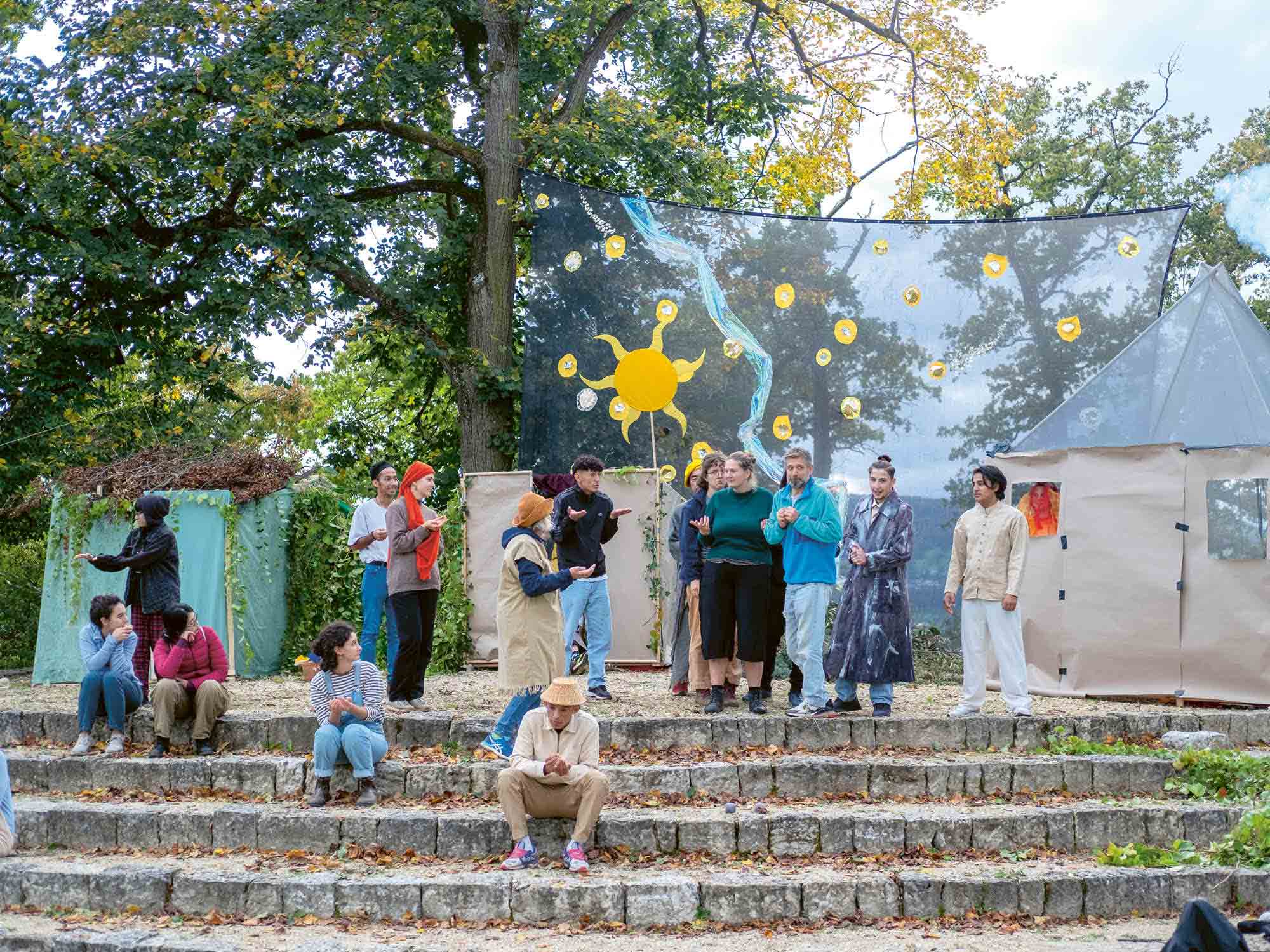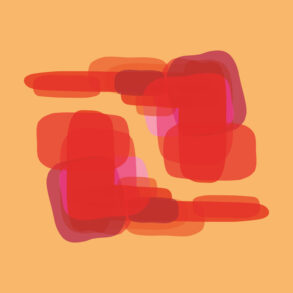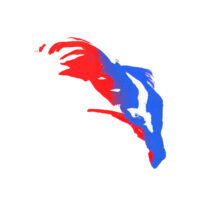All that is good, beautiful, and true comes in threes—sweet, salty, and sour; heads, hands, and hearts; darkness, light, and color. And stories, so they say, do too.
One—the Beginning: Setting the Stage
Once upon a time, there was a village built on a long-forgotten sacred site, surrounded by a dark forest. Three brothers lived in the village, each with a unique task. The youngest brother, Faith, was wise and knowledgeable in the movements of the planets and stars. At sunset, he would awaken and seek counsel from the heavens, which he shared with his older brother, Love, who was the keeper of the sacred fire. This brought light to all the inhabitants of the dark forest who traveled to the village each morning to meet Love and receive their share of the ever-abundant flame. Every morning, the eldest brother, Hope, would let the people into the village through the door of his own house, and at dusk, he would wave goodbye to each flame bearer before closing the door until the next morning and the morning after that…

So begins the fairy tale created and performed by an unlikely group of storytellers and artists of all kinds who came from all corners of the world to take part in the fourth edition of Frage! Begegne! Spiele! (Question! Encounter! Play!) at the Goetheanum. “Frage” is an inclusive arts program designed to promote cooperation and inclusion through the arts among young Europeans, migrants, and refugees living in Switzerland. But this is only one side of the story. From the point of view of the participants, “Frage” is “a week to look forward to the whole year,” “a space to empty myself, to be myself,” and “to meet one’s chosen family”—it is an opportunity to see each other beyond cultural or racial differences, to play, to question, to be human together.
The story of the program began in 2019, on a train ride in Switzerland, when two members of the Youth Section team reflected on the list of challenges that a group of young Norwegians had recently shared with them. They described a loss of trust in older generations and in humanity as a whole, of loneliness and fear for the future. They shared experiences of paralyzing doubt brought on by the endless choices that they cannot find the will to commit to. They spoke of a lack of meaning and hope for their lives and the lives of others. Not far from the train, in Dornach, two other people were helping young immigrants from Afghanistan to integrate, some of whom had to risk and give up everything to come to Europe in the hope of finding security and the freedom to determine their own future.

In 2021, in the midst of the Covid pandemic, the team behind “Frage” brought together the first group of players: young Europeans and refugees from Afghanistan, Syria, and Eritrea. The pilot program was made possible thanks to Caritas Switzerland, Freunde der Erziehungskunst, and Movetia, who supported the main organizations behind the project: the Youth Section at the Goetheanum and the Initiative Forum for Refugees. For a week, these young people lived and cooked together, made music, rehearsed a script they’d written, and shared their biographical journeys with each other. At the end of the week, they gave an original theatre performance on the Felsli in the Goetheanum gardens. It was not originally planned as an outdoor event—it was simply the only way to share their work with the community in the midst of pandemic restrictions. Now, four years later, the Felsli has become the open stage, rain or shine, where four original plays have been created and performed by over 80 participants from more than 30 countries who have taken part in the program.
Two—the Middle: the Confrontation and the Catastrophe
All was well in the life of the village until, one day, three dark strangers arrived. They have been traveling from place to place, looking for gold or anything shiny in exchange for entertainment. Their greed drains all the wealth from the people they meet. The people feel deceived and eventually throw the strangers out of their communities. When the performers arrive in the village of Faith, Love, and Hope, they try their cheap tricks on the people of the forest. But unlike the other places, the villagers pay them no attention… and no money. The strangers soon discover the reason for the villagers’ lack of interest: no amount of light amusement can distract them from the sacred flames that Love has faithfully shared that day. When the strangers discover the village’s treasure, they want it for themselves, but when they approach Love for their share of the fire, they find that they cannot touch the flames without getting hurt. Filled with hatred, they devise a plan of revenge to destroy the village. They hide the Moon from Faith so that he is misled and goes back to sleep without consulting the stars; they give Love their counsel instead, persuading him that the fire must be hoarded, lest one day there not be enough to go around, and that he should only give out a little and keep the rest for himself in his house. Finally, they convince Hope that he should let the villagers in as if it were a normal day, only this time, they would all receive less of the flames than they need, and some would get none at all. Love, trusting the advice of the strangers, dutifully puts some of the flames aside in his own house, which begins to burn down. The fire spreads throughout the village and the strangers’ plan is almost complete. They urge Hope to open the door and sow fear into the hearts of the forest dwellers, who desperately try to put out the fire. By the end of the evening, the sacred fire is extinguished, and the village is reduced to ashes. Who is to blame? Who is to blame? The desperate villagers fall prey to rumors started by the strangers and sink into shame and blame for their loss. Faith, Love, and Hope decide to take the responsibility and leave the village.
One of the central questions of “Frage” is: how can the modern soul strengthen its capacity to face and transform life’s pain? In his 1911 lecture series entitled “Faith, Love, Hope,” Rudolf Steiner pointed out that in the future, “when people are depressed or unhappy, they will find the help of their fellows less and less important and valuable”1 because of the growing forces of individuality. He said that “the best advice that can be given for the future is to make our souls strong and full of energy, so that with increasing strength, as we advance into the future, we may realize that newly awakened faculties give us the knowledge of the Great Counsellor, who at the same time becomes the judge of a man’s karma, the knowledge of Christ in a new form.”2 Through this new relationship with —or revelation of—the Christ-being, people will be able to perceive directly the necessary karmic deeds that they must perform. In this way, they can replace the prevailing hereditary laws that have dictated moral action for individuals bound by blood to a particular race or culture. In the future, those who have strengthened their souls will be able to draw counsel from the original source of meaning, the Logos, and thereby give meaning to their own actions.

It’s Saturday evening at the Youth Section House, and we’ve been working together for six days on this year’s program. Norullah is 18 years old and originally from Afghanistan. He fled to Iran with his family when he was 7. As an Afghan child, he was not allowed to go to school there. He had no identity papers, and, like many Afghans, he and his family lived on the margins of society. His parents wanted him to get an education and paid for him to go to school. He considers himself to be interested in many things and says that after “Frage,” he is more eager to learn. He has been in Switzerland for a few years, and this is his second year in the program. On a previous evening, he told me about the history of the Hazara people and the persecution they suffered at the hands of Abdur Rahman Khan at the end of the 19th century. This evening he shares his thoughts on how language shapes culture, the incoherence of radical Islamism, fear on a boat from Turkey to Italy, the possibility of alternative realities, and different understandings of God. “Someone in Iran once told me,” he says, “that God is in the middle and that there are many different paths, but they all lead to God. The paths are the different religions.” We talk a while longer and arrive at a new question: could it be that there is one unique path for each of us that can only be walked alone, but which undoubtedly leads us to God? “Yes, that makes sense,” we say to each other.
In the biography sessions during the week, we focus on the individual stories of the lives of the participants and the questions that each of them carries with them. It’s impossible to tell this one common story without the forty-three individual stories, and we want to acknowledge each of them. The biographies are explored in a three-day journey where the participants are guided through different viewpoints from which to see themselves.
The first day is dedicated to the brother Faith, and the first viewpoint is the image of the faithful moon that accompanies the earth as it circles the sun, generously sharing its light in the night. This awakens in us an experience of the meaning of reflection. Then, each of us walks alone through the streets and woods of Dornach towards the Goetheanum’s Holzhaus, remembering “who you have been” until this week. In the Holzhaus, we create a constellation of our own life’s milestones, using natural elements such as plants, sticks, stones, magazine clippings, photos, and drawings to represent significant moments that have left a mark on us.
The second day of the biographical work is dedicated to the brother Love and the image of the sun, which gives light and warmth to all beings, unconditionally. This time, we journey to the Holzhaus in pairs, each describing to the other the revelations of the previous days’ reflections. We are invited to step into our own “sun” to face the question “Who am I now?” and to write a poem that begins with the line “when my heart speaks…”
“I am a bubble in the waves of life,” writes one participant in Arabic, German, and English. “When my heart speaks, it does so patiently, wisely, warmly, and surely,” writes another in Spanish. From others, in German: “When my heart speaks, it is I, everything and nothing,” and “… then it speaks in many colors.” Another says, “Run, my love, to the top of your mountain,” “I am only a traveller,” and “When my heart speaks, the words are silent.” When the poems are finished, we form a circle, and each of us takes a turn at the centre. From the inside, we read a passage aloud, from our sun hearts, while the others listen from the periphery, radiating light and warmth.

Three—the Ending: the Resolution
What gives strength to the soul in the face of catastrophe? Where do we get what we need in the darkest of times when even Faith, Love, and Hope seem to have left us? Albert Steffen once wrote in his Notebook:
Often the happenings of the world appear so meaningless that one no longer has any desire to do anything. One has to let everything go. Well at least, do not let yourself go. Give your own life meaning. Then in spite of everything—through your deed—something meaningful prevails—even in approaching chaos.3
The third day of the biographical journey asks participants to take a leap of faith and envision a hopeful future for themselves. The guiding image is Saturn, the most distant planet still visible to the naked eye, reflecting the sun’s light to the earth. It is an ancient threshold between earthly experience and the heavens. From this standpoint, the oldest brother, Hope, sees beyond what has been and what is to what will be. Participants are invited to transform their life story into their own fairy tale on one condition: it must have a happy ending. Hope is not easy, but it is possible—we can will it.
It is the mark of a good story, that, however fantastic or terrible the adventures, it can give to child or man that hears it, a catch of the breath, a beat and lifting of the heart, near to (or indeed accompanied by) tears (…) A piercing glimpse of joy, and heart’s desire, that for a moment passes outside the frame, and lets the gleam come through.4

On the Friday before the performance, we still do not have an ending for our story. In a first attempt, the strangers listen to the memories of the villagers, regret what they have done, and decide to go into the dark forest like Faith, Love, and Hope. The villagers tell them to stay; there have been enough losses, and they are forgiven. But the ending does not ring true. Is regret enough? What does it mean to take real responsibility? What is the essence of forgiveness? Is redemption of evil really possible? And what does freedom mean if we depend on others to forgive our mistakes?
The team stays late on the Felsli this evening with these questions, earnestly thinking them through, hoping to find an answer that will clarify how redemption may come about —a resolution that honors the catastrophe. As happens every year, in the run-up to the final “Frage” performance, they do not know if they will succeed or if they will arrive at some kind of truth. But they know that they are striving for something meaningful and that in that process, they hope to create something significant out of a genuine study of human nature—its conditions, its context, its struggle, and its contemporary reality.
Humbly, the team presents the players with a new ending. Maybe this was not their favorite, maybe there was a better one, but a trust has been built between all of us. It is grounded on having seen each other, and from that meeting place, it allows us to play together and accompany each other in a leap of faith. We know that no right or wrong will be discerned while in the process but that an earnest search for the good, the beautiful, and the truth in every story is worth striving for. It is in this quest that we meet each other as players, as artists, and as people who are just on their way…
In the darkest of times, the villagers begin to remember Faith, Love, and Hope. They begin to tell each other stories that seem to have slipped from another world through a crack in the fairy tale. Although they are beautiful, the memory of the three brothers is not enough to bring them back, nor to breathe life back into the flames. The strangers, however, are moved by the villagers’ stories, which start to kindle memories of their own. They were not always like this: once upon a time, they had faith in themselves, they performed out of love, and they sang songs of hope. A village musician calls out: “I remember you!” He approaches them, speaking in a foreign language, yet one that everyone can understand. “Help us remember!” they say. The musician sings a song that the strangers had sung, once upon a time —a song about the stars, trembling with love and hope. They hear their old song and, as if transformed by the melody, their dirty grey cloaks fall away, and they become what they have always been: beings in the likeness of Faith, Love and Hope. And, as if summoned by the final notes of the song, the three brothers, Faith, Love and Hope, return to rekindle the sacred flame, which can now burn brighter and more real than ever before.
Infomation
Frage! Begegne! Spiele! is a concept developed by a team of social workers, educators, and artists working with the Goetheanum’s General Anthroposophical Section and Youth Section, and the Anthroposophical Society in Switzerland. In 2024, it was delivered in collaboration with Caritas Schweiz, The Necessary Teacher Training College and The Youth Initiative Program. The project would not be possible without the support of the Goetheanum’s Gartnerei, Betriebsdienst team and Costume department, as well as the financial support from the Edith Maryon Stiftung, Mahle Stiftung, Movetia’s Youth in Action Program, Stiftung Freie Gemeinschaftsbank and Swisslos. A special thanks to Rafael Tavares (Goetheanum Bühne) and the Rudolf Steiner Archive who kindly allow the Felsli to become a world stage for a week.
Images From the rehearsals and performance of the project. Photos: Mahdi Hosseingholi
Footnotes
- “Faith, Love and Hope, The Third Revelation,” GA 130, December 02, 1911, in Faith, Love, and Hope (1964) Rudolf Steiner Archive (n.d.).
- Ibid.
- Steffen, A. (1945) From a Notebook.
- Tolkien, J. R. R., Flieger, V., & Anderson, D. A. (2008) Tolkien on Fairy-stories.









